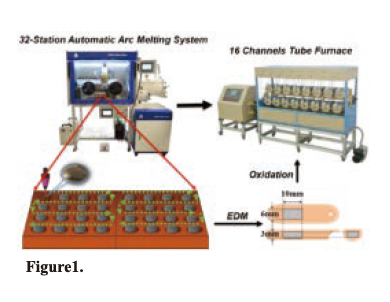Yi Liu1*, Ziqiang Dong1, Yanjie Liu1, Jianhui Chen1, Jintao Shu1
1Materials Genome Institute, Shanghai University, Shanghai, 200444, ChinaChina
EXTENDED ABSTRACT: Nb-based alloys exhibit excellent high-temperature mechanical properties with low densities but are prone to oxidation. Aiming to understand fundamentally the alloying effects on the oxidation behaviors of Nb-based alloys, we combined the first-principles density functional theory and Kinetic Monte Carlo simulations to perform high-throughput computations (HTC) systematically on the binding energies, energy barriers, and diffusion coefficients of oxygen in Nb-X alloys where X = thirty 3d, 4d, and 5d transition metal (TM) elements plus Al and Si. We classify the alloying effects into three categories: (a) local short-range trapping effects (X=V, Ti, Cr, Y, Zr, and Hf); (b) local long-range trapping effects (X = Si and Ru); (c) non-local non-trapping effects (X = Mo, W, and Al). Our results show that the solute elements with the short-range trapping effects at near regions had the most effective reduction effects on the O diffusion coefficients while the long-range trapping effects and the non-local effects are less significant but non-negligible. Specifically, the reduction effects of the partially studied alloying elements decrease in the order of Y>V>Ti>Si>Cr>Zr>Hf>Al>Mo>Ru>W. Furthermore, the high-throughput experiments (HTE) were utilized to verify the computational prediction. The oxidation behaviors of binary Nb-Xm alloys (X= Cr, Si, Al, Ti, V, W, Hf, Mo, Zr; m= 0.5, 2, 5 at%) were evaluated at 350℃ and 450℃, respectively. Our experiments found the alloying elements hindering the oxygen diffusion in the order of V>Ti>Si>Cr>Al>W>Hf>Mo>Zr. Based on the high-resolution microstructure analysis, the oxidation mechanism was finally discussed. The combined high-throughput computation and high-throughput experiments can be used to study intrinsic alloying effects systematically on the oxygen diffusion in Nb-based alloys, providing the rational evidence for the composition design of oxidation-resistant Nb alloys.
Keywords: High-throughput experiments; High-throughput computations; Alloy design; Nb-based alloys; Oxidation resistance
REFERENCES
[I l Jianhui Chen, Yuchao Tang, Fu Liu, Jintao Shu, Yanjie Liu, Ziqiang Dong, Yi Liu*. Alloying Effects on the Oxygen Diffusion in Nb Alloys: A First-Principles Study, Metallurgical and Materials Transactions A, 2021, 52, 270—283.
[2] Jintao Shu, Ziqiang Dong*, Chen Zheng, AnKang Sun, Shuang Yang, Tao Han, Yanjie Liu, Zihan Wang, Shujuan Wang, Yi Liu*, High-throughput experiment-assisted study of the alloying effects on oxidation of Nb-based alloys, Corrosion Science, 2022, 204, 110383.


Prof. Yi LIU obtained his Ph. D. degree at Materials Science and Engineering at Institute of Metal Research in China in 1997. Then he has worked in the field of computational materials science at Nagoya University, Japan (1997-2002); Juelich Research Center, Germany (2002-2003); University of Western Ontario, Canada (2003-2005); California Institute of Technology, US (2006-2012). He is a professor at Materials Genome Institute and Department of Physics at Shanghai University (2015-present) after worked at the School of Materials Science and Engineering, the University of Shanghai for Science and Technology (2012-2015). His current research interests focus on the materials design for advanced alloys, combustion fuels, and nanomaterials by combining high-throughput computation, high-throughput experiment, and machine learning approaches based on materials genome concept.